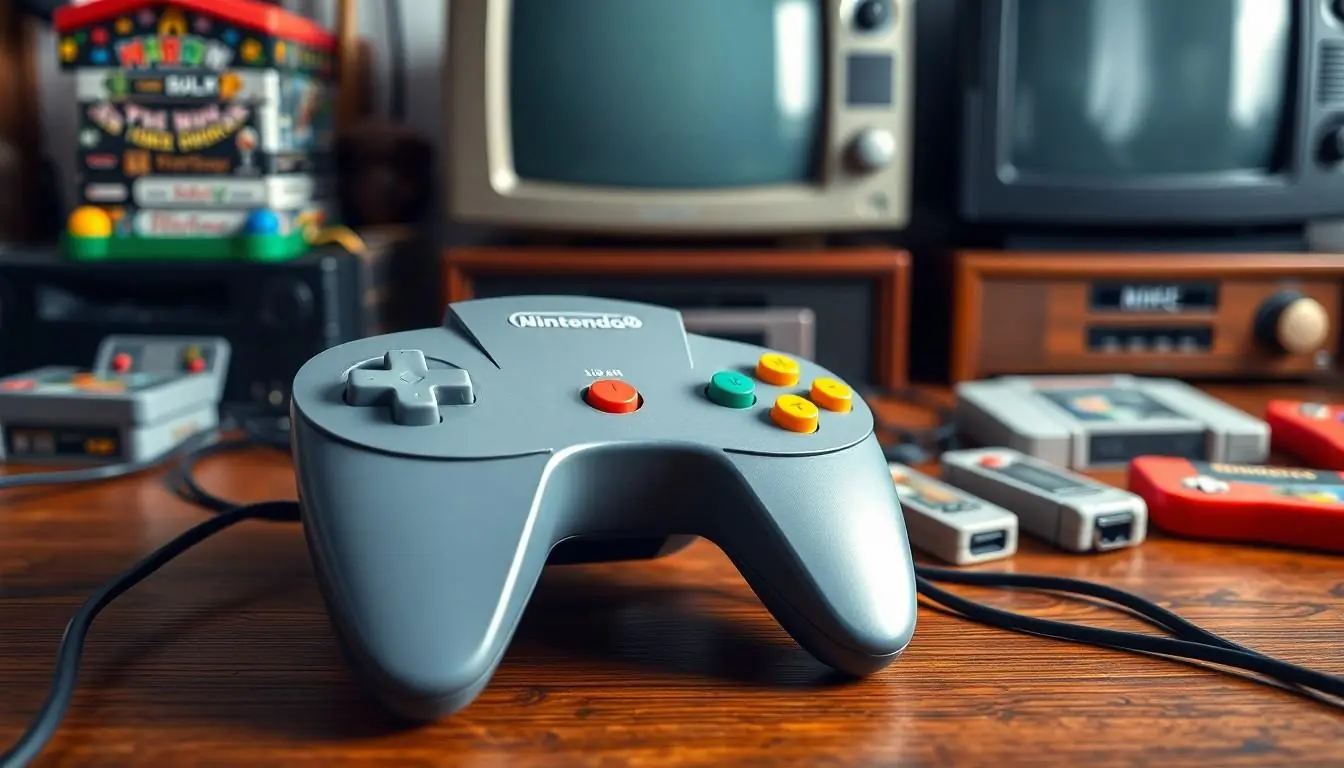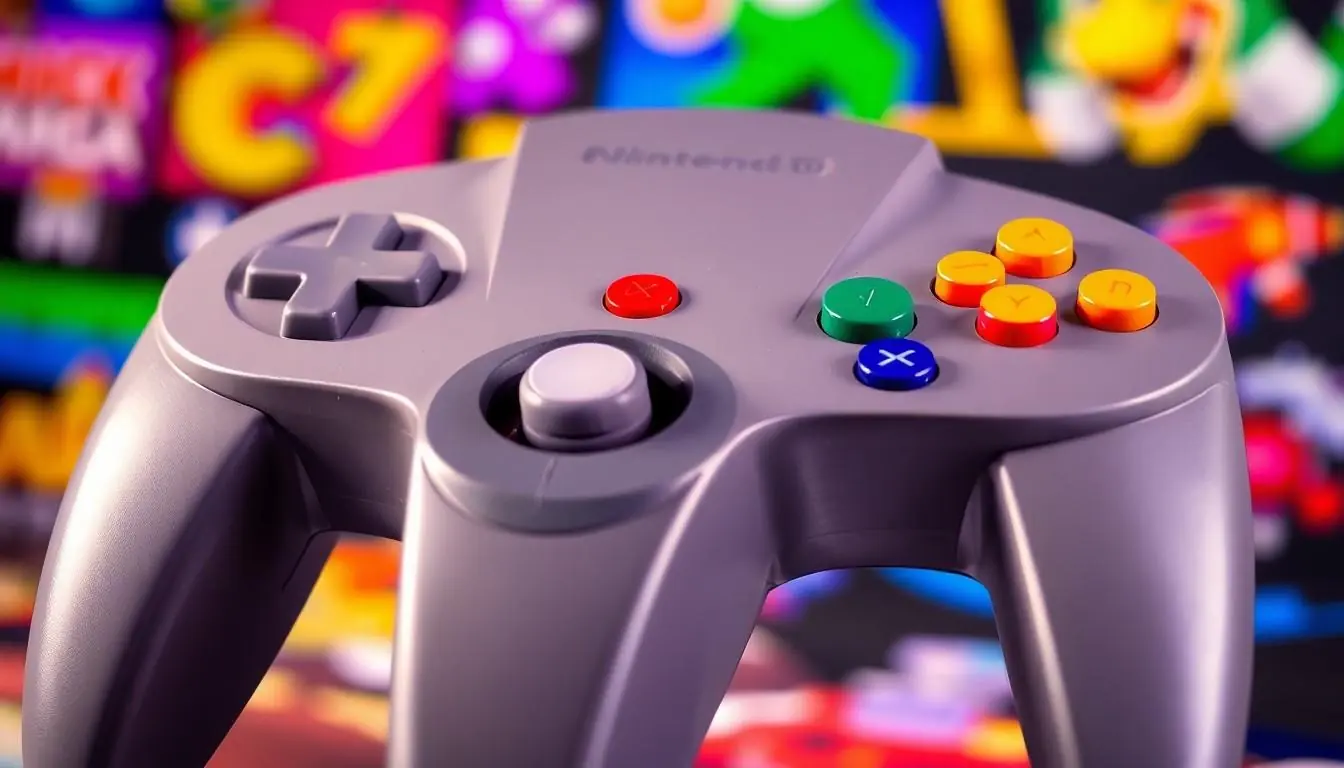Picture this: it’s the late ’90s, and you’re nestled in your living room, ready to embark on an epic adventure with your trusty Nintendo 64 remote in hand. This iconic controller isn’t just a piece of plastic; it’s a portal to a world of vibrant graphics and unforgettable gameplay. From racing through Rainbow Road to battling it out in Super Smash Bros, the N64 remote has been the unsung hero of countless gaming marathons.
But it’s not just nostalgia that makes this controller special. Its unique design and innovative features set it apart from the rest. Whether you’re a seasoned gamer or a curious newcomer, understanding the magic behind the Nintendo 64 remote can elevate your gaming experience. So grab your popcorn and settle in, because it’s time to explore why this controller remains a beloved relic in the gaming universe.
Table of Contents
ToggleOverview Of The Nintendo 64 Remote
The Nintendo 64 remote, known as the N64 controller, holds a distinctive place in gaming history. Its innovative three-pronged design encourages diverse grip styles, appealing to a wide range of players. Including an analog stick, the controller enhances precision, allowing for smoother character movement in 3D environments. The built-in trigger and buttons facilitate intuitive gameplay, promoting engagement in popular titles like “Super Mario 64” and “The Legend of Zelda: Ocarina of Time.”
Notable for its unique button layout, players encounter A and B buttons prominently positioned for easy access. The C buttons serve as a versatile interface for camera control and menu navigation, adding depth to gameplay mechanics. A rumble feature, introduced through the Rumble Pak accessory, further immerses gamers by providing tactile feedback during pivotal moments.
The Nintendo 64 remote also supports multiplayer gaming, with easily accessible ports for connecting additional controllers. This functionality allows for exciting local competition, fostering social interaction among players. The colorful design and iconic shape contribute to its recognition, making it a memorable symbol of 90s gaming culture.
Over time, gaming enthusiasts celebrate the N64 controller for its contribution to the evolution of game controllers. Its impact on game design inspires modern controllers, proving that it remains a significant force in the industry. The nostalgic value continues to resonate, inviting both old and new players to explore the unique offerings of the Nintendo 64.
Design And Ergonomics
The Nintendo 64 controller features a design that enhances gameplay. Its unique three-pronged shape allows players to grip it comfortably, catering to various holding styles.
Button Layout
Button placement on the N64 controller is intentional. Large A and B buttons sit prominently, making them easy to access during fast-paced action. C buttons surround the analog stick, assisting camera control and item selection. The Z trigger, positioned under the controller, provides a natural aiming experience in shooting games. This thoughtful arrangement contributes to seamless gameplay in iconic titles such as “Super Mario 64” and “The Legend of Zelda: Ocarina of Time.” Overall, the layout’s responsiveness promotes a satisfying user experience.
Comfort And Grip
Comfort remains paramount in the N64 controller’s design. Its ergonomic contour fits comfortably in various hand sizes. Textured grips enhance stability, preventing slips during intense gaming sessions. Players often appreciate the balance between the weight of the controller and ease of movement. Additional features like the Rumble Pak not only add immersive feedback but also influence grip during use. This combination of comfort and functionality solidifies the controller’s place as a staple in gaming, appealing to both casual and dedicated gamers alike.
Functionality And Performance
The Nintendo 64 controller delivers functionality that enhances gameplay experiences. Its versatility caters to various gaming styles and preferences, making it a standout accessory for the console.
Wireless vs. Wired Options
Wired controllers provide a direct connection to the console, ensuring stability and low latency during gaming. Players appreciate the reliability of wired connections, especially in competitive environments. Wireless options, though, offer freedom of movement, reducing clutter and enhancing comfort. Some players may prefer the absence of wires, creating a cleaner setup. Compatibility exists through adapters, allowing wired controllers to be used in newer gaming systems. Ultimately, both options present benefits, accommodating the diverse preferences of gamers.
Range And Responsiveness
Responsiveness stands at the forefront of gaming performance. The Nintendo 64 controller maintains a strong connection, delivering quick response times that enhance gameplay precision. Data indicates that the analog stick’s sensitivity and movement translate into fluid navigation in games. Players experience minimal lag, which is critical in fast-paced scenarios. Range varies slightly between wireless models, but most maintain reliable performance within a reasonable distance from the console. This capability ensures that players remain engaged without disruptions, contributing to a seamless gaming experience.
Compatibility With Games
The Nintendo 64 remote integrates seamlessly with an extensive library of games, enhancing the overall gaming experience.
Popular Titles Supporting The Nintendo 64 Remote
Significant titles include “Super Mario 64,” which showcases the controller’s analog stick for precise movement. “The Legend of Zelda: Ocarina of Time” offers engaging gameplay, utilizing the trusted button layout for intuitive control. Other notable games like “Mario Kart 64” and “GoldenEye 007” leverage multiplayer functionality, allowing friends to join in on the action with additional controllers. “Cruis’n USA” also demonstrates responsiveness during fast-paced racing scenarios, making the controller essential for various genres.
Limitations And Issues
Several limitations affect the Nintendo 64 controller’s compatibility. Elasticity can diminish over time, leading to less responsive analog sticks. Furthermore, the C buttons can pose challenges with specific game mechanics, causing frustration in certain titles. Wired versions restrict mobility, hindering a fluid gaming environment. In contrast, wireless options might introduce slight latency, impacting precision in competitive situations. Connection issues may arise with aging controllers, affecting the overall experience during gameplay.
User Experience And Feedback
Users consistently express appreciation for the Nintendo 64 controller, reflecting its design and function across various gaming environments. Players highlight the comfortable grip that accommodates different holding styles. Feedback often mentions the responsive analog stick, allowing for precise movement in 3D games. Many gamers love the simplicity of the button layout, particularly enjoying how easily accessible the A and B buttons enhance gameplay flow. The inclusion of the Rumble Pak adds a layer of immersion, making gameplay feel more dynamic and engaging. Overall satisfaction remains high, especially among those revisiting classic titles.
Conversely, common complaints about the N64 controller often stem from its long-term durability. Some users note issues with analog stick wear and its impact on precision during gameplay. Challenges with the C buttons receiving specific criticism include difficulty in navigation for complex titles and inconsistent responsiveness. Wired models draw concerns regarding cable length, limiting movement in larger setups. Even wireless options face scrutiny from competitive players due to minor latency, which can disrupt high-stakes gaming moments. Users recognize these drawbacks while still valuing the nostalgic experience the controller provides.
Conclusion
The Nintendo 64 controller remains an iconic piece of gaming history that continues to resonate with players. Its innovative design and functionality set the stage for an unforgettable gaming experience. With its unique grip styles and responsive controls, it’s no wonder the N64 controller has left a lasting impact on both casual and dedicated gamers.
As players explore classic titles and modern adaptations, the nostalgia associated with the N64 controller enhances their enjoyment. Despite some limitations, its contributions to gameplay and multiplayer interaction are undeniable. The legacy of the Nintendo 64 remote lives on, inviting new generations to discover the charm and excitement of this beloved controller.




